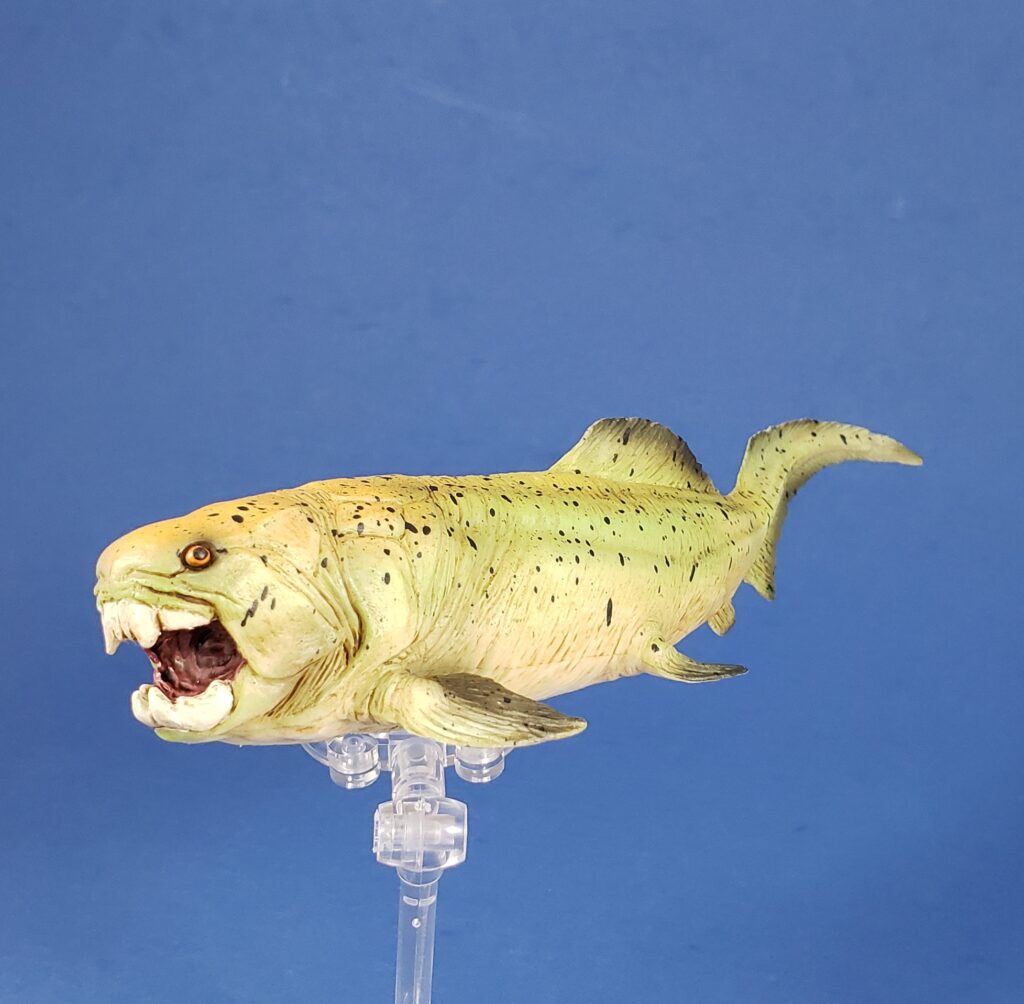
350 million years before the advent of humans, reindeer, or consumerism, our distant gnathostome forebears celebrated Fishmas. Fishmas originated when Santa Claus turned the wrong dial on the time machine he uses to travel to every house in the same night, landing him in the Devonian and the gaping maw of a Dunkleosteus. Fish have been celebrating this auspicious occasion every 26 December since. Unfortunately, the decadent tetrapods abandoned this hallowed tradition when they abandoned their aquatic habits. Here to celebrate this ancient feast day (made so much more enjoyable by the evolution of jaws!) is Mojö’s rendition of Dunkleosteus, the famous Devonian arthrodire from Cleveland (okay, for the sticklers, the type locality is in the inner-ring suburbs). Mojö’s is a solid middle-of-the-road offering: it looks pretty good, it’s affordable, and in terms of anatomy it gets some things wrong and others right. You could certainly do worse in the Dunkleosteus department.
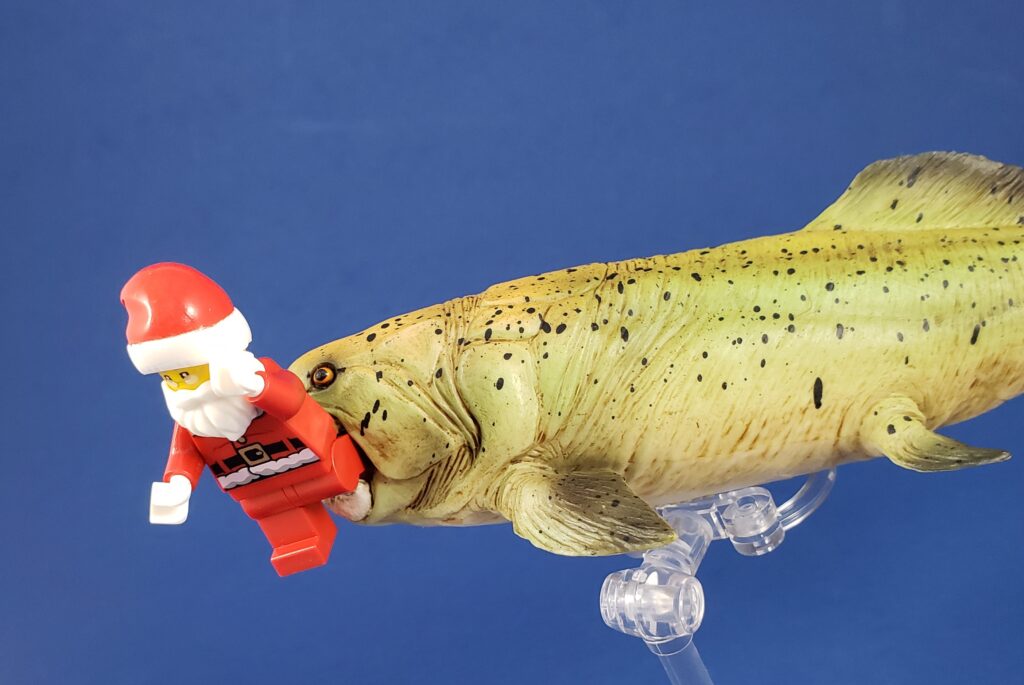
A bit more than 20 cm long, with a maximum head width of just under 2.5 cm, this figure is plausibly 1:35-1:40 scale. It’s sculpted in a straight-ahead swimming pose, with its mouth open to chomp down on some other unfortunate placoderm or maybe a mollusk. The tail is undulating laterally for propulsion, like a tadpole or eel. It’s mainly a chartreuse color, with a pale yellowish belly, and a dorsal streak of dull orange across the top of the head and thorax. There are random black speckles on the sides and top, including on some of the fins, which are also tipped with a dark wash. This color scheme isn’t the first I’d think of for a large oceanic predator, but to be honest I like the break from gray fishes.
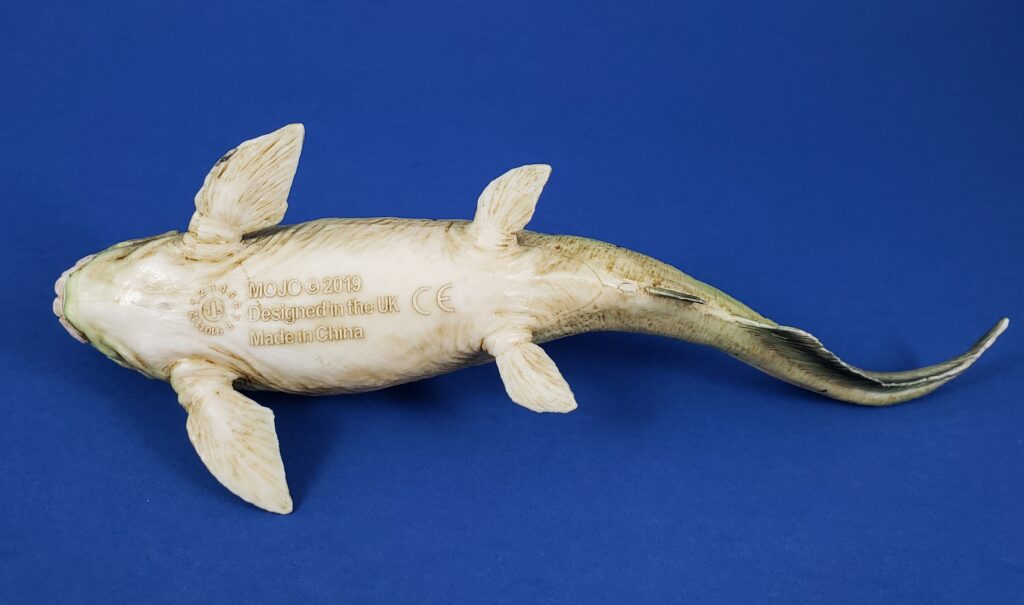
The body is mostly covered in smooth, if slightly loose, skin. The skin covering the head and thoracic armor is the same color as the adjoining areas. The ventral thoracic plate is either missing or completely buried in skin. I tend to think it should be visible, but I’m not aware of a reason that its being completely covered is impossible. Overall, I think the extensive skin covering is a strong feature of this figure. The skin on the midsection is a bit too wrinkly for my taste; I’d expect a big marine prowler to be a little more taut (imagine going for a swim in baggy pajamas rather than a wetsuit). However, this toy deserves credit for eschewing the osteoderms that plague some Dunkleosteus depictions.
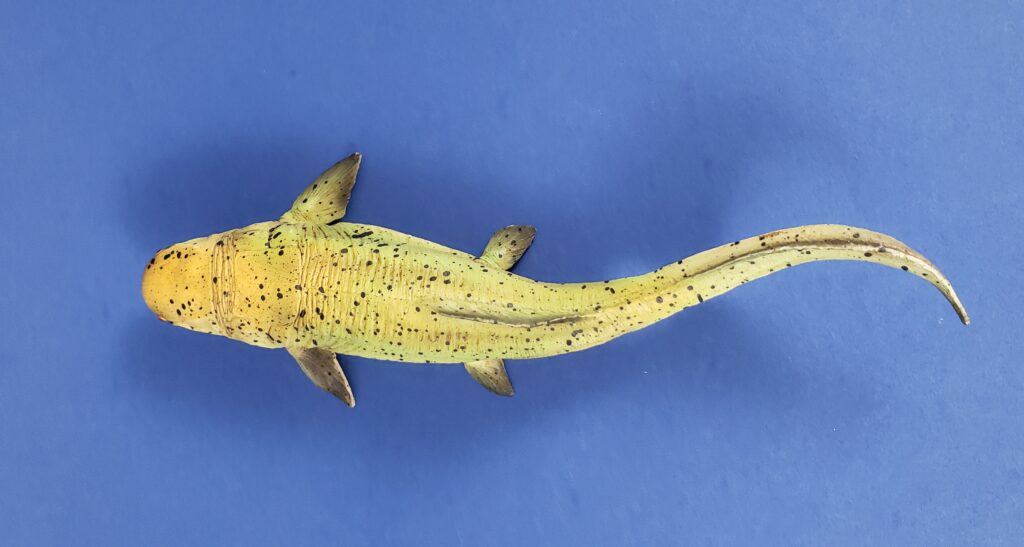
The head is reasonably well-proportioned, although the suborbital plates (just beneath the eye) are a little too flush with the jaw; with the mouth open their lower edges should flare out. The big shearing plates at the front of the mouth are even partially covered with skin, although personally I’d have given a little more ‘lip’ to the lower jaw. The eyes look to be alone in their sockets, bulging and orange. Fish eyes come in all sorts of crazy colors, so that’s fair enough, but there should be a little soft tissue around the eyeballs. Eyeballs do best when there are muscles to control their direction, and fat to cushion them from shocks. I’ll bet a large fish that spent its time chomping other animals with its face bones would want some of that cushion. And don’t get me started on eyelids. Still, I’d be remiss not to point out that this toy commendably avoids the common error of putting the sclerotic rings outside the eyeball.

The fins are a mixed bag. The pectoral and pelvic fins are in plausible positions, although they should probably look more shark-like and less coelacanth-like. The dorsal fin is way too far back, and too low–it probably would have had a more triangular shape, again like that of a shark. Similarly, the tail should look much more shark-like, with distinct upper and lower lobes, and it’s quite likely that the area just before the tail was constricted and fairly inflexible. This would have the effect of reducing side-to-side motion (yaw) during swimming. The Mojö figure would be a nightmare to propel if it were scaled up to 6 or 8 meters.
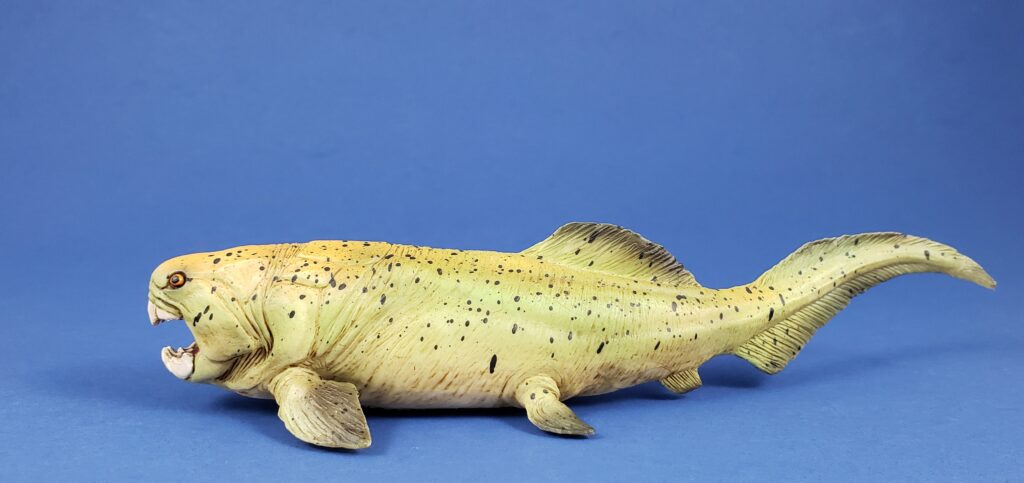
If you’re only going to buy one Dunkleosteus for your Fishmas festivities, I’d probably recommend the Favorite Co. or Safari Ltd versions. But there are much worse versions out there, and if you want a school of ’em, this one is worth the $15 or so that it will cost you.

Disclaimer: links to Ebay and Amazon on the DinoToyBlog are affiliate links, so we make a small commission if you use them. Thanks for supporting us!



10/10 Review, thank you
Poor Santa!
I recently acquired this model in a brick and mortar toy shop. I could pick from the entire Mojo line and chose a fish, which tells you all you need to know.
I love this figure and I can’t believe it just now got reviewed.
Always interesting to read about all the anatomical details, fascinating.
Great review and hope Santa made it back!
Sorry I took so long! I’ve planned to review it since it came out, but I moved to a new city between then and now…
I honestly would have liked a dunkleosteus by Mojo of a more acceptable size, for example the same size as its counterpart from Collecta and even from Papo. On the other hand, the figure is quite acceptable although it is not one hundred percent scientific as the article points out, but nevertheless it has a point in its favor that it does not have an articulated jaw that obviously favors the figure of any prehistoric animal when it comes to avoid seams that greatly ugly the figure of the dinosaur.
Nice review. About the tail…….to my knowledge it is pure speculation that it had a shark like tail. There is a tendency in Paleontology to exaggerate both size and abilities of extinct fauna, to make them more appealing and exciting to the general population. Also, paleontologists are constantly coming up with new ideas on well known extinct genera, to make their mark, in the scientific community……they are human beings, after all and want professional recognition like most people.
And I think Dunk. is a case of this. It is quite reasonable to believe it had the Safari ltd type tail, in fact, in my opinion, it is quite likely it did. This would have made it a slower swimmer, but so what? That could be one of the reasons it went extinct. I am totally thumbs down on a shark like tail for Dunk.
Dunk’s size is another case of exaggeration. Some references quote it as being 30 feet or more. Adding a 30 foot body to the largest skull found would make Dunk look like an eel, not a fish. The more accepted size for Dunk, in the scientific community, is ‘up to 20 feet’. A very detailed scholarly paper I read online recently described Dunk as being ‘great white shark size’. Great Whites average about 15 to 16 feet long (for females, males are a bit smaller), with only one Great White in the world known to have reached 20 feet. Scaling the largest Dunk skull known to these dimensions produces an animal much like the Safari, Mojo and Schleich figures. And I feel that in broad strokes, any of them is a reasonable representation of Dunk’s appearance in life…all the figures have some detail errors, and Safari’s is probably the best,
Thanks for your thoughts. There’s a lot here! I’ll answer as best I can.
It’s certainly true that the morphology of arthrodire tails is a subject of debate, and the sharklike tail I favor is not an empirical fact but a theoretical prediction. Because arthrodire fins were made of organic, rather than mineralized, material, there are very few entire outlines preserved in the fossil record. However, I think calling the crescent-tail hypothesis ‘pure speculation’ is ungenerous. It’s based on the observation that ceratotrichia-based fins often significantly exceed the area implied by the underlying rigid elements, and the observation that large fishes frequently have this tail shape. The latter observation comports with predictions from biomechanical principles; namely, propelling a large body with a tail that allows turbulence to gather close to the streamline (https://en.wikipedia.org/wiki/Streamlines,_streaklines,_and_pathlines) becomes exponentially more difficult as volume increases, because increased volume reduces the effective viscosity of the medium, which in turn exacerbates yaw. We have two competing lines of evidence: the tadpole tail in well-preserved Coccosteus tails, and predictions from biomechanics. Coccosteus is at most 1/10 the length and less than 1/100 the mass or volume of Dunkleosteus. It’s experiencing water in a fundamentally different way. We also know that fishes evolve crescent-shaped tails that shed vortices away from the streamline frequently when they achieve large body size: sharks, sturgeons, tunas, swordfishes, pachycormids, ichthyodectids, even minnows like Ptychocheilus and catfishes like Pangasius. From the standpoint of development, it’s an easy transition to make because it doesn’t require any new ingredients, just changing how long existing ingredients spend growing. Even marine tetrapods, which you’d expect to have a hard time making a crescent-shaped tail, have done so repeatedly: mosasaurs, ichthyosaurs, teleosaurids. Mosasaurs managed it in a very short interval, much shorter than the interval between the first arthrodires and Dunkleosteus terrelli (tens of millions of years). Finally, as to the speculation that an eellike tail could have led to the extinction of dinichthyids, there were two major Late Devonian extinction events that wiped out not only placoderms, but many other fish lineages and plenty of invertebrates. It seems to have had everything to do with changes in the environment and any individual extinction probably can’t be ascribed to a particular morphological feature.
As far as scale goes, the length estimates you cite rely on a shorter, stouter trunk than the Mojo figure depicts. We don’t know how long Dunkleosteus was, but we know how wide its head could get, so that’s what my scale estimate is based on. Based on a large head width of about 1.3 m, the rather small-headed Mojo figure is about 1:35-1:40; that doesn’t agree with length estimates because Mojo made the body more elongate than paleoichthyologists currently think it was (compared to the small head). I could have been more explicit about how I arrived at this estimate, but generally I prefer to use elements of known length to scale figures, rather than speculative total lengths.
For what it’s worth, I mostly share your jaundiced views on professional science, but I still think the reasoning and math underlying the crescent-tail hypothesis is pretty sound. You’re free to disagree, of course, but I hope this makes clearer why I favor the sharklike tail.
And yeah, there is no Dunk figure that gets everything right, but as is often the case with frequently-made taxa, it comes down to which errors bug you more. On that rubric, I like the Favorite version best, but Safari’s version is also a great choice.
great response….you’ve given me a lot to think about and investigate. My view on Dunk’s tail may be due to a subtle prejudice I have that more ancient creatures weren’t as sophisticated as more recent creatures. And a crescent tail is more ‘sophisticated’ than a tadpole like tail. I hope your wrong though….I prefer the way Dunk looks without the shark like tail 🙂
Where did you find that Dunk’s head was 1.3m wide? I can’t find any reference to that.
Excellent question! I am no longer sure where I got that number, but I’ve been using it for several years, starting with the Schleich Dunk. I reviewed that in 2016, at which time I was working at the Field Museum. It’s possible that it’s from the specimen on display there, but honestly I don’t think that one is quite so large. The University of Michigan Museum web site has an interactive skull of a CMNH specimen that you can measure directly in-browser: https://umorf.ummp.lsa.umich.edu/wp/wp-content/3d/viewer.html?name=1336&extension=ctm
But that one is only about 77 cm across at its widest point. The 1.3m number probably comes from larger but fragmentary specimens rather than this very complete one. If I figure out where I got that measurement I’ll post an update here.
Thanks. I’d be interested to know where that dimension comes from. If the head was 1.3m across that would have to translate to an animal of at least 25 feet in length; far larger than the ‘Great White Shark’ size animal I have come to accept for Dunk. Btw I’ve been assuming we’re talking about terrelli, the largest species, this whole time. Just to clarify.
I’ve been looking at the Favorite model and while it nicely captures the shark like tail you described, the problem I have with it is that it looks like a shark with a Dunkleosteus head stuck on it. I have my doubts that is what the real fish looked like. The tiny pectoral fins bug me too.
I just don’t see selective pressures sculpting Dunk’s body to be sleek and streamlined, with a strong, efficient swimming tail, but retain the big clunky, unstreamlined and heavy head stuck on the front. If there had been pressure to be fast, then the head would have evolved too.
So often things seem clear that they should have been one way but turn out to be another. Nature constantly throws curve balls. Spinosaurus being a good recent example of this. It was universally accepted that it would have had long or long-ish legs, but instead it turns out it had short stumpy, impractical looking ones. Yet it clearly thrived and reached enormous size. So i’m still clinging to the tadpole like tail, for Dunk. 🙂